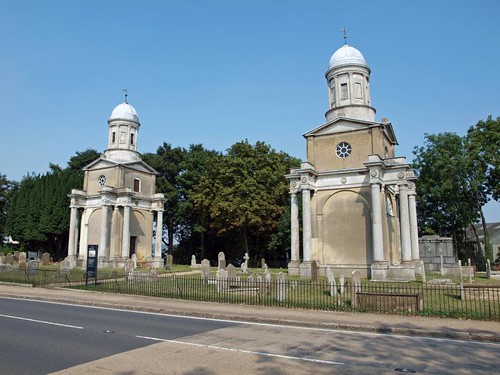As an aside St Mary is one of only two English churches designed by Adam (although he did do the interior of St Mary at Croome Park), the other being St Andrew at Gunton Hall in Norfolk which is now in the care of the CCT as noted by Simon Knott here.
As a further aside of the six churches he was either involved in or designed - Cumnock in Ayshire, St George's Chapel in Edinburgh, St Mary in Mistley have been demolished or partially demolished, St Mary, Croome Park and St Andrew, Gunton Hall are in the care of the CCT and Yester Chapel in Lothian is redundant, status unknown.
Naturally the towers are haunted and exhaustive research can be found here although, I'm afraid, the results are slightly inconclusive.
ST MARY. This new church (see Mee below) was consecrated in 1735. It was a plain parallelogram of brick and would not be worth special attention here, if it had not been radically changed by Richard Rigby in connexion with his grander plans. He began by altering Mistley Hall (no longer extant) which had been built by his father, made the grounds picturesque in the fashionable landscape style, built Gothic and Chinese temples, bridges and so on, and then called in Robert Adam, apparently in 1774. He was to design a bagno, that is a salt water bath by the river, the other side of the malting office. Drawings for this exist, but it was never carried out. Next came the church. This was taken in hand in 1776. What Robert Adam did, was to add a square tower at the N end and another at the S (ritual E) end, and porticoes with two pairs of Tuscan columns each at the two long sides. The result was extremely original and far from religious-looking. The towers were adorned with free-standing Tuscan columns, each with a piece of projecting entablature on top, as if they were angle buttresses gone classical. Above the entablature was a square storey with four pediments, and then a slim circular drum with attached Ionic columns and a crowning dome. The duplication of the towers so far distant from each other was not aesthetically wholly successful. The intervening nave prevented them from being seen as one, and today that is even more difficult, since the two towers alone survive. The nave has been pulled down, and the portico columns have been re-used to continue the motif of the buttressing by columns on the sides where formerly the nave stood. This buttressing motif, even if derived from Roman precedent, is handled very daringly and no doubt impressed Sir John Soane a great deal. The pulling down of the nave was connected with the building of yet another church.
MISTLEY. It has two ruined churches and a new one, and it has seen trade on the Stour draw its people down from the hill to the banks of the river. One of the ruins is a fragment of a medieval church, the porch alone remaining. Built about 1500, it has a moulded plinth inlaid with panels of flint, and the buttresses and the doorway have much beauty in them. The other ruin is of a 18th century church, forlorn twin towers down in the town. There are memories of the 18th century church in the new one, a handsome place in the park with a spire 140 feet high. Its pleasant interior has been enriched by a carved organ case from Worcester Cathedral and a beautiful window of the Last Judgement.
On the walls is a tablet in memory of Richard Rigby, a notorious politician who was Paymaster-General in the corrupt days of the taxation which lost America for the flag. It is said that he was no better than he should have been, and he is remembered because he raised his voice against the public funeral of Chatham, and because when he died in 1788 he was found to have amassed about half a million of money out of his public services.

No comments:
Post a Comment